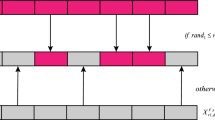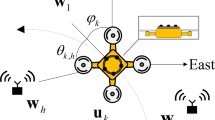Abstract
Visual tracking technology can provide measurement information for unmanned helicopter formation and thus, more attention is being paid to this research area. We propose a novel mean shift (MS) algorithm that is both adaptive and robust for unmanned helicopter formation and apply it to the leading unmanned helicopter tracking. The movement of an unmanned helicopter is very flexible and changeable, which makes the tracking there of more difficulty than for common targets. In creating an algorithm that can adapt to the acceleration of the unmanned helicopter and estimates both the scale and orientation of the movement changes, we combine the traditional MS with the bio-inspired Cauchy predator-prey biogeography-based optimization (CPPBBO) evolutionary algorithm, and also the space variant resolution (SVR) mechanism of the human visual system (MS-CPPBBO-SVR). To demonstrate the effectiveness and robustness of the proposed method and justify the importance of the CPPBBO algorithm and SVR mechanism at the same time, a series of comparative experiments were carried out. The experimental results of the proposed MS-CPPBBO-SVR method are compared with other competitive tracking methods, such as MS, MS with SVR (MS-SVR), MS-SVR with several other optimization algorithms, and the robust particle filter algorithm. The experimental results demonstrate that our proposed tracking approach, MS-CPPBBO-SVR, is more adaptive, robust and efficient in target tracking than the other methods.
Similar content being viewed by others
References
Lin F, Lum K Y, Chen B M, et al. Development of a vision-based ground target detection and tracking system for a small unmanned helicopter. Sci China Ser F-Inf Sci, 2009, 52: 2201–2215
Duan H B, Zhang Y P, Liu S Q. Multiple UAVs/UGVs heterogeneous coordinated technique based on Receding Horizon Control (RHC) and velocity vector control. Sci China Tech Sci, 2011, 54: 869–876
Duan H B, Luo Q N, Ma G J, et al. Hybrid particle swarm optimization and genetic algorithm for multi-UAV formation reconfiguration. IEEE Comput Intell Mag, 2013, 8: 16–27
Zhang X Y, Duan H B, Yu Y X. Receding horizon control for multi-UAVs close formation control based on differential evolution. Sci China Inf Sci, 2010, 53: 223–235
Duan H B, Liu S Q. Nonlinear dual-mode receding horizon control for multiple UAVs formation flight based on chaotic particle swarm optimization. IET Contr Theor Appl, 2010, 4: 2565–2578
Li J R, Li H Y, Tang G J. Optimal multi-objective trajectory design based on close-looped control for autonomous rendezvous. Sci China Tech Sci, 2011, 54: 3091–3097
Duan H B, Li P. Progress in control approaches for hypersonic vehicle. Sci China Tech Sci, 2012, 55: 2965–2970
Duan H B, Luo Q N, Yu Y X. Trophallaxis network control approach to formation flight of multiple unmanned aerial vehicles. Sci China Tech Sci, 2013, 56: 1066–1074
Cai G W, Chen B M, Peng K M, et al. Modeling and control of the yaw channel of a UAV helicopter. IEEE Trans Ind Electron, 2008, 55: 3426–3434
Peng K M, Dong M B, Chen B M. Design and implementation of a fully autonomous flight control system for a UAV helicopter. In: Proceedings of the 26th Chinese Control Conference, Zhangjiajie, 2007. 662–667
Wang R, Xia P Q. Control of dynamic stall of helicopter rotor blades. Sci China Tech Sci, 2013, 56: 171–180
Wang G L, Xia H, Yuan X M, et al. Modeling the yaw dynamics of an unmanned helicopter through modes partition method. Sci China Tech Sci, 2012, 55: 182–192
Fukanaga K, Hostetler L D. The estimation of the gradient of a density function, with applications in pattern recognition. IEEE Trans Inf Theory, 1975, 21: 32–40
Zhang C L, Jing Z L, Jin B, et al. A dual-kernel-based tracking approach for visual target. Sci China Inf Sci, 2012, 55: 566–576
Ning J, Zhang L, Zhang D, et al. Scale and orientation adaptive mean shift tracking. IET Comput Vis, 2012, 6: 52–61
Xiao G, Yun X, Wu J M. A multi-cue mean-shift target tracking approach based on fuzzified region dynamic mage fusion. Sci China Inf Sci, 2012, 55: 577–589
Wang C Y, Zhang H Q. An adaptive kernel bandwidth mean-shift target tracking algorithm. In: Proceedings of IEEE International Conference on Control Engineering and Communication Technology, Shenyang, 2012. 547–550
Li Y. Adaptive mean shift using hybrid particle swarm algorithm. J Huazhong Univ Sci Technol, 2010, 38: 47–49
Duan H B, Shao S, Su B W, et al. New development thoughts on the bio-inspired intelligence based control for unmanned combat aerial vehicle. Sci China Tech Sci, 2010, 53: 2025–2031
Costae Silva M A, Coelho L D S, Lebensztajn L. Multiobjective biogeography-based optimization based on predatorprey approach. IEEE Trans Magn, 2012, 48: 951–954
Schwartz E L, Christman D R, Wolf A P. Human primary visual cortex topography imaged via positron tomography. Brain Res, 1984, 294: 225–230
Simon D. Biogeography-based optimization. IEEE Trans Evol Comput, 2008, 12: 702–713
Comaniciu D, Ramesh V, Meer P. Kernel-based object tracking. IEEE Trans Patt Anal Mach Intell, 2003, 25: 564–576
Simon D, Ergezer M, Du D W. Markov models for biogeography-based optimization and genetic algorithms with global uniform recombination. IEEE Trans Syst Man Cybern Part B-Cybern, 2011, 41: 299–306
Yan L, Jiang J P. Convergence and escape capacity research of evolution learning strategies. Acta Automat Sin, 2005, 31: 873–880
Lorenz E N. Deterministic nonperiodic flow. J Atmos Sci, 1963, 20: 130–141
Chang C, Ansari R. Kernel particle filter for visual tracking. IEEE Signal Process Lett, 2005, 12: 242–245
Lin L K, Xu H, Sheng W D, et al. Multi-target state-estimation technique for the particle probability hypothesis densty filter. Sci China Inf Sci, 2012, 55: 2318–2328
Xu C F, Duan H B, Liu F. Chaotic artificial bee colony approach to uninhabited combat air vehicle (UCAV) path planning. Aerosp Sci Technol, 2010, 14: 535–541
Liu F, Duan H B, Deng Y M. A chaotic quantum-behaved particle swarm optimization based on lateral inhibition for image matching. Optik, 2012, 123: 1955–1960
Duan H B, Sun C H. Pendulum-like oscillation controller design for micro aerial vehicle with ducted fan based on LQR and PSO. Sci China Tech Sci, 2013, 56: 423–429
Zhang S H, Ou J P. BP-PSO-based intelligent case retrieval method for high-rise structural form selection. Sci China Tech Sci, 2013, 56: 940–944
Duan H B, Yu Y X, Zhao Z Y. Parameters identification of UCAV flight control system based on predator-prey particle swarm optimization. Sci China Tech Sci, 2013, 56: 012202
Author information
Authors and Affiliations
Corresponding author
Rights and permissions
About this article
Cite this article
Wang, X., Duan, H. Biologically adaptive robust mean shift algorithm with Cauchy predator-prey BBO and space variant resolution for unmanned helicopter formation. Sci. China Inf. Sci. 57, 1–13 (2014). https://doi.org/10.1007/s11432-014-5135-3
Received:
Accepted:
Published:
Issue Date:
DOI: https://doi.org/10.1007/s11432-014-5135-3




